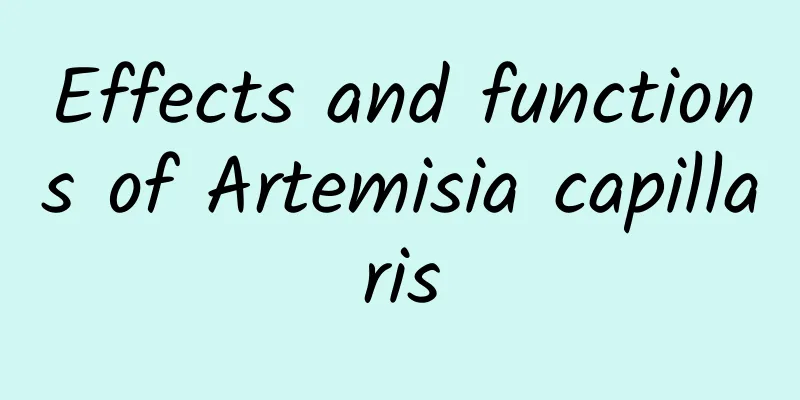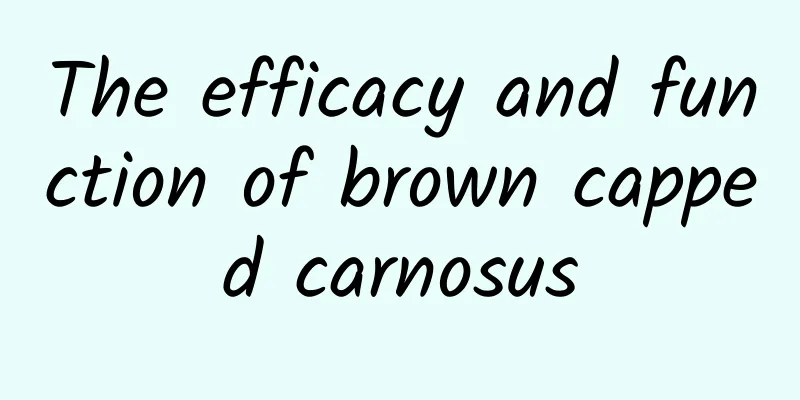Effects and functions of Artemisia capillaris

|
The medical value of Artemisia capillaris is beyond our imagination. It is very effective in treating some diseases. Artemisia capillaris contains many substances that are beneficial to the human body. Let’s take a look. [Alias] Yellow flowered wormwood, hanging bell grass, spiritual wormwood, blowing grass, five poisonous grass, Xu poison grass, ghost sesame oil, Liu Qinu, bell wormwood, earth wormwood, horn wormwood, jar tea, mountain wormwood, golden flower screen, black wormwood, iron rod wormwood, mountain sesame, jar grass, northern Liu Jinu, joint bottle, grass wormwood, pot bottle grass, wild oil sesame, mountain sesame seedling, mountain oil sesame, yellow head Weng, lock grass, centipede grass, star anise wormwood, sesame wormwood [Source] Medicinal material source: the whole herb of Yinxingcao of the Scrophulariaceae family. [Original morphology] Shade grass is an annual herb, 30-70cm tall. The whole plant is densely covered with rusty short hairs. The roots are branched. The stem is single, erect, multi-branched at the top, slightly angular, and light red at the top. Leaves are opposite; without pomelo or with short petioles; leaf blades are bipinnately divided, linear or linear-lanceolate, about 8mm long and 1-2mm wide. Flowers grow oppositely at the upper part of stems and branches, forming sparse racemes; pedicels are extremely short, with a pair of bracteoles, linear; calyx tube is 1-1.5cm long, with 10 prominent main veins, 5 calyx teeth, 1/4-1/3 of the tube length; corolla upper lip red-purple, lower lip yellow, 2-2.5cm long, tube straight, upper lip sickle-shaped, slightly rounded forehead, back covered with long cilia, lower lip 3-lobed at the tip, folds gathered into petal-like, covered with short soft hairs on the outside; 4 stamens, didyna, filaments hairy at base, lower part fused to corolla tube; style long, slightly thick and curved at tip. The capsule is broadly oval, with a slightly flattened tip and enclosed in a persistent calyx. Seeds black. Flowering period is July-August, and fruiting period is August-October. [Habitat distribution] Growing on hillsides and grasslands. Flat cloth shoes all over the country. [Chemical composition] The whole plant of Artemisia capillaris contains 3-hydroxy-16-methylheptadecanoic acid, apigenin, luteolin, β-sitosterol, tetratriacontane and pentatriacontane. The above-ground parts contain siphonostegiol, isocantleyine and loliolide. : : : : : : : : : : : : : : : : : : : : : : : : : : : : : : : : : : : : : : : : : : : : : : : : : : : : : : : : : : : : : : : : : : : : : : : : : : : : : : : : : : : : : : : : : : : : : : : : : : : : : : : : : : : : : : : : : : : : : : : : : : : : : : : : : : : : : : : : : : : : : : : : : : : : : : : : : : : : : : : : : : : : : : : : : : : : : : : : : : : : : : : : : : : : : : : : : : : : : : : : : : : : : : : : : : : : : : : : : : : : : : : : : : : : : : : : : : : : : : : : : : : : : : : : : : : : : : : [Pharmacological action] 1. Hepatoprotective and choleretic effect: The decoction of Yinxingcao was gavaged into mice at 10g/kg and 5g/kg, and liver damage was induced by carbon tetrachloride. The two doses of Yinxingcao could reduce serum ALT by about 1.0%, which was significantly different from the control group. Oral administration of Yinxingcao decoction (6g/kg) or total alkali (350mg/kg) and total flavonoids (2g/kg) extracted from Yinxingcao can significantly reduce the high serum ALT level in rats caused by gossypol acetate, but has no significant effect on carbon tetrachloride-induced liver damage. Oral administration of concentrated decoction of Yinxingcao has a significant choleretic effect on anesthetized dogs and rats. [Toxicity] After a single oral administration of 130 g/kg of Yinxingcao decoction, a few mice developed mild diarrhea after 2 days. No mice died after 7 days of observation. The maximum tolerated dose is 216.6 times the clinical dose for adults. The median lethal dose of total alkaloids and total flavonoids of Herba Lycopodii in mice after oral administration was 1.54±0.23g/kg and 17.25±13g/kg, respectively. [Processing] Take the original medicinal materials, remove impurities and residual roots, wash them with water, moisten them slightly, cut them into middle sections, dry them, and sieve out the ash. Medicinal properties: Mixed slices of stems, leaves and flowers. The whole body is gray-brown, densely covered with rusty or yellowish-white short soft hairs. The stem is round, with opposite branch marks or petiole marks, hard in texture, and with yellow-white pith on the cross section. The leaves are wrinkled, curled, broken, dark green or dark brown. The calyx is tubular, persistent, yellow-brown or black-brown, with 10 distinct longitudinal ridges and 5-lobed tip. Slight odor, light taste. Store in a dry container in a ventilated and dry place to prevent moth damage. 【Nature and flavor】 Bitter; Cool 【Functions and indications】 Clears away heat and dampness; cools blood and stops bleeding; removes blood stasis and relieves pain. It is used for jaundice due to damp-heat, enteritis and dysentery, turbid urine, carbuncle and erysipelas, hematuria, blood in stool, traumatic bleeding, dysmenorrhea, amenorrhea due to blood stasis, traumatic injury, and arthritis. [Usage and Dosage] For oral use: decoct in water, 9-15g, fresh product 30-60g; or grind into powder. For external use: take appropriate amount, grind into powder and apply on the affected area. [Additional prescription] The stems and leaves are similar to Artemisia annua, and it has the effect of removing dampness and jaundice, so it is named "Artemisia capillaris". The corolla is tubular and lip-shaped, yellow in color, hence the name "Golden Bell". The names of "bell, horn, jar, hanging bell, pot and bottle" are all the same. "Illustrated Catalogue of Plant Names and Realities" says: "Mingxing and Yinchen are the same in the southern dialect. The Song Dynasty's "Illustrated Classic" says that there are several species of Yinchen, and this is one of them." Wild sesame, wild oil hemp, etc. are also named because the plants and seeds are similar to sesame. 【Excerpt】 Chinese Materia Medica Through the above, we have learned about the effects and functions of the traditional Chinese medicine Artemisia capillaris. I hope everyone can find the right medicine for their condition and consume Artemisia capillaris correctly in life. |
<<: The efficacy and function of Campanula
>>: The efficacy and function of golden duckweed
Recommend
Tie a "green ribbon" to the "Sea of Death"
In the heart of the Taklimakan Desert, known as t...
This ubiquitous element almost turns all of humanity into fools
Produced by: Science Popularization China Author:...
What are the effects of Laimahui?
Most of the herbs have medicinal value, and so do...
Why is aging called "old age and yellowing of beauty"? Can premature yellowing be avoided?
Once spring is over, the beauty will fade away. W...
Were the Yue people 2,500 years ago "tide-proof architects"? Archaeological excavation of the kingdom of Goujian, King of Yue →
Recently, the "Yue State Archaeology: Shaoxi...
Is the Dark Star reliable? Explaining hypersonic vehicles
The American military blockbuster "Top Gun 2...
Is neck wrinkle cream really effective? A 45-day comparison of the results...
Some people say that the neck is a woman’s second...
Can the elderly eat ginseng in summer?
Ginseng is a traditional Chinese medicine and als...
The efficacy and function of red sand
Speaking of red sand, many people know that it is...
A woman got HPV while getting a manicure. Is it true or not? Experts say it’s not true!
Recently, the news that manicures may cause infec...
A 39-year-old vegetarian internet celebrity in Russia has passed away. He used to insist on eating only fruits. Is it good to be a vegetarian? Here are 11 common misconceptions
According to media reports, a Russian vegetarian ...
Wild boars are causing harm in 26 provinces! How to prevent wild boars from running wild?
On October 25, a wild boar broke into a roadside ...
Gaining weight, fatigue, lethargy...may be caused by a lack of this vitamin
Audit expert: Wang Xuejiang Professor of Pathophy...
How to eat Tianma
For the ingredient Gastrodia elata, it is mainly ...
Yogurt, vinegar, honey water, do these hangover remedies really work? | Science Gallery
The Spring Festival is the most important traditi...









